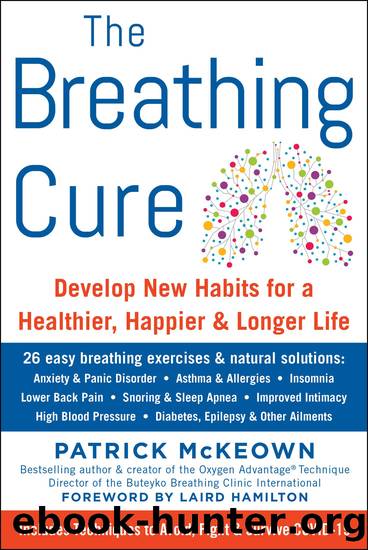The BREATHING CURE: Develop New Habits for a Healthier, Happier, and Longer Life by Patrick McKeown

Author:Patrick McKeown [McKeown, Patrick]
Language: eng
Format: epub
Tags: Health & Fitness, diseases, Respiratory, Allergies, Alternative Therapies, Alzheimer's & Dementia, Exercise, Aerobics, Naturopathy, Body Cleansing & Detoxification, pain management, Immune & Autoimmune, healing, Homeopathy, Healthy Living, Holism, Longevity, Self-Help, Self-Management, Stress Management
ISBN: 9781630061982
Google: OVslEAAAQBAJ
Publisher: Humanix Books
Published: 2021-07-27T23:38:10.576521+00:00
THE VITAL ROLE OF THE DENTIST
Dr. William Hang, a Los Angelesâbased airway-centric orthodontist, describes the dentist as the gatekeeper to the airways.27 Researchers Peter Catalano and John Walker also state,
The most likely person to diagnose a child with SDB is their family dentist or orthodontist. This is directly related to the fact that nasal breathing has a tremendous impact on craniofacial development, which in turn determines dental profile and occlusion (how the teeth align). Over 90% of children with crooked teeth, teeth grinding, or malocclusion (misalignment of the teeth) have compromised nasal breathing.9
In the United States, thanks to a joint effort by American Academy of Pediatrics and American Academy of Pediatric Dentistry, children are ensured a âdental homeâ by the time they reach the age of 1 year. This means that pediatric dentists have a higher frequency of patient encounters than most other allied health professionals.15 A 2017 study of 55 children, more than 65% of whom were mouth breathers, concluded that âRecognition of mouth breathing in young persons by orthodontists is poor.â28 But why is this the case? Why isnât SDB in children, its causes and treatment, primarily the domain of the pediatric dentist? And why is it so often not even picked up by dentists?
The connection between nasal breathing and dental issues was first observed in the 1970s by a Norwegian orthodontist, Dr. Egil Harvold. Harvold noticed that many patients who came to him with dental issues were also mouth breathers, and he decided to investigate further. In 1981, he published the results of his landmark study, âPrimate experiments in oral respiration,â in which he compared baby monkeys whose nostrils were blocked with silicone plugs with a control group.29 For six months, as the monkeys grew, those animals whose noses had been plugged began to mouth breathe by default. This led to many changes in craniofacial development. The faces of the monkeys whose noses had been blocked looked very different from those who were able to breathe nasally. They developed long faces, misaligned teeth, and altered face and neck muscles as the body adapted to form an oral airway. Even after the nasal obstruction was removed, they continued to mouth breathe for as much as a year, while their altered facial features were retained.29
A 1998 paper by American orthodontist Katherine Vig questioned Harvoldâs results. Vig explains that, while Harvold fully blocked the noses of the monkeys, total nasal obstruction in humans is âextremely rare.â30 However, I believe that Dr. Vig is missing the point. The issue is not the extent of nasal obstruction, it is whether or not the child is mouth breathing. The studies by Harvold investigated if persistent mouth breathing in monkeys caused craniofacial abnormalities. The study results showed this to be the case. A new review published in 2018 reported that children with nasal obstruction were 5.55 times more likely to mouth breathe.5
A study in the American Journal of Orthodontics in 1997 also looked at the effects of nasal obstruction on craniofacial growth in young Japanese macaque monkeys.
Download
This site does not store any files on its server. We only index and link to content provided by other sites. Please contact the content providers to delete copyright contents if any and email us, we'll remove relevant links or contents immediately.
Spare by Prince Harry The Duke of Sussex(5077)
Machine Learning at Scale with H2O by Gregory Keys | David Whiting(4195)
Fairy Tale by Stephen King(3223)
Will by Will Smith(2795)
Hooked: A Dark, Contemporary Romance (Never After Series) by Emily McIntire(2502)
The Bullet Journal Method by Ryder Carroll(2487)
Rationality by Steven Pinker(2291)
Can't Hurt Me: Master Your Mind and Defy the Odds - Clean Edition by David Goggins(2230)
It Starts With Us (It Ends with Us #2) by Colleen Hoover(2203)
Friends, Lovers, and the Big Terrible Thing by Matthew Perry(2126)
The Becoming by Nora Roberts(2091)
Love on the Brain by Ali Hazelwood(1965)
HBR's 10 Must Reads 2022 by Harvard Business Review(1779)
The Strength In Our Scars by Bianca Sparacino(1778)
A Short History of War by Jeremy Black(1764)
Leviathan Falls (The Expanse Book 9) by James S. A. Corey(1651)
515945210 by Unknown(1602)
A Game of Thrones (The Illustrated Edition) by George R. R. Martin(1594)
Bewilderment by Richard Powers(1541)
